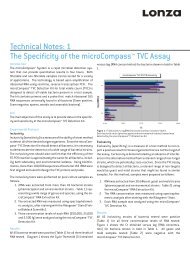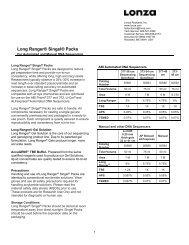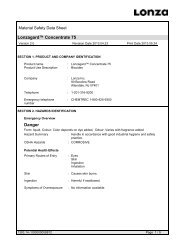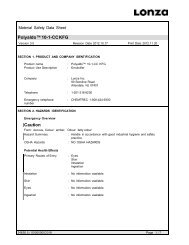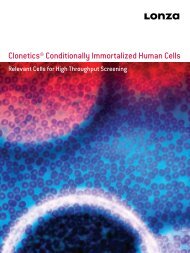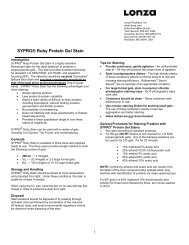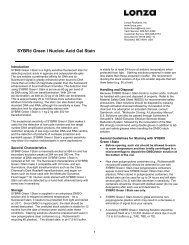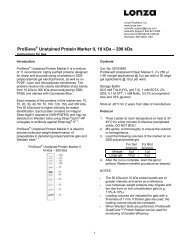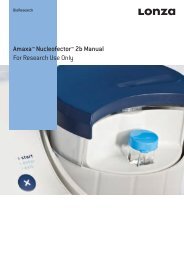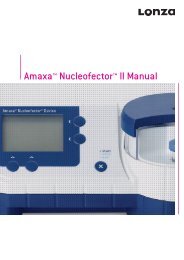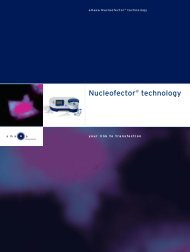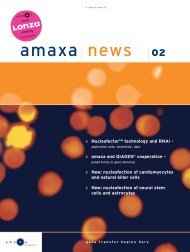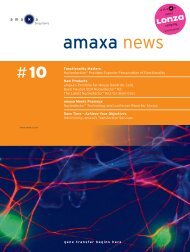Nucleofector technology and transient protein production
Nucleofector technology and transient protein production
Nucleofector technology and transient protein production
Create successful ePaper yourself
Turn your PDF publications into a flip-book with our unique Google optimized e-Paper software.
amaxa xxxxxxxxxxxx <strong>Nucleofector</strong> <strong>technology</strong><br />
research<br />
<strong>Nucleofector</strong> ® <strong>technology</strong><br />
<strong>and</strong> <strong>transient</strong> <strong>protein</strong><br />
<strong>production</strong><br />
your link to transfection
<strong>Nucleofector</strong> <strong>technology</strong><br />
The <strong>Nucleofector</strong> ® <strong>technology</strong> <strong>and</strong><br />
<strong>transient</strong> <strong>protein</strong> <strong>production</strong><br />
Transient <strong>protein</strong> expression systems have gained increasing<br />
relevance as they enable fast <strong>and</strong> flexible <strong>protein</strong> <strong>production</strong>.<br />
Protein amounts up to 10 mg can be produced within<br />
a few days in contrast to <strong>production</strong> periods up to<br />
several months using stably transfected cell clones.<br />
Transient <strong>protein</strong> <strong>production</strong> offers:<br />
› fast <strong>production</strong> of small scale <strong>protein</strong> amounts<br />
› low costs for cell maintenance<br />
Easy <strong>and</strong> fast nucleofection procedure:<br />
harvest of<br />
<strong>protein</strong><br />
Combine cells of interest, expression<br />
vector <strong>and</strong> the appropriate celltype<br />
specific <strong>Nucleofector</strong> ® Solution<br />
<strong>and</strong> transfer to an amaxa certified<br />
cuvette.<br />
Insert the cuvette into the <strong>Nucleofector</strong> <strong>and</strong> choose the cell-type<br />
specific <strong>Nucleofector</strong> program. Press the start button “X”. After a<br />
few seconds nucleofection is completed. Rinse the cuvette with culture<br />
medium <strong>and</strong> transfer the cells into the culture flask. For 1 x 10 8<br />
cells, ten cuvettes have to be nucleofected.<br />
Culture cells for several days.<br />
In the past gene transfer into serum-free cultivated mammalian<br />
cells suitable for <strong>protein</strong> <strong>production</strong> was hampered<br />
by inefficient transfection methods.<br />
The <strong>Nucleofector</strong> <strong>technology</strong> represents the ideal tool for<br />
gene transfer even into hard-to-transfect cell lines like<br />
suspension CHO cells.<br />
It has now been successfully tested <strong>and</strong> validated for its use<br />
in <strong>transient</strong> <strong>protein</strong> <strong>production</strong>.<br />
Benefit from <strong>transient</strong> <strong>protein</strong> <strong>production</strong> using nucleofection:<br />
› suitable for sCHO, sHEK-293, BHK-21, NS0 <strong>and</strong> many other<br />
cells<br />
› applicable even under serum-free conditions<br />
› high transfection efficiencies<br />
› low DNA amounts<br />
page 2 www.amaxa.com <strong>Nucleofector</strong> <strong>technology</strong>
<strong>Nucleofector</strong> <strong>technology</strong><br />
Nucleofection ® is superior to lipofection<br />
for <strong>transient</strong> <strong>protein</strong> <strong>production</strong><br />
In a comparative study the <strong>Nucleofector</strong> <strong>technology</strong> (amaxa)<br />
<strong>and</strong> the lipofection reagent Lipofectamine 2000 (Invitrogen)<br />
have been tested in regard to their suitability for <strong>transient</strong><br />
<strong>protein</strong> <strong>production</strong>.<br />
Nucleofection achieves 10 -30 times higher expression rates<br />
in CHO cells compared to cells transfected with lipofection. A<br />
similar ratio has been determined for both the specific <strong>and</strong><br />
the volumetric productivities.<br />
Experimental setup:<br />
2 different suspension CHO cell clones have been transfected with a plasmid<br />
encoding the human secreted alkaline phosphatase (SEAP) either using<br />
Lipofectamine 2000 (Invitrogen) or nucleofection.<br />
Transfection conditions:<br />
Cell line<br />
sCHO-clone1<br />
(ECACC)<br />
sCHO-clone2<br />
(Invitrogen)<br />
Transfection<br />
method<br />
Lipofectamine<br />
2000<br />
nucleofection<br />
Lipofectamine<br />
2000<br />
nucleofection<br />
Transfection<br />
conditions<br />
290 µl<br />
Cell Line Kit V<br />
Program U-024<br />
580 µl<br />
Cell Line Kit V<br />
Program U-024<br />
DNA<br />
58 µg<br />
pDRIVE-hSEAP<br />
25 µg<br />
pDRIVE-hSEAP<br />
116 µg<br />
pDRIVE-hSEAP<br />
25 µg<br />
pDRIVE-hSEAP<br />
Cell number<br />
5 x 10 7<br />
(^= 5 samples)<br />
5 x 10 7<br />
(^= 5 samples)<br />
5 x 10 7<br />
(^= 5 samples)<br />
5 x 10 7<br />
(^= 5 samples)<br />
Post transfection cells were cultivated as batches in spinner flasks containing<br />
50 ml culture medium for 5 days under non-regulated conditions.<br />
Suspension HEK-293 cells (DSMZ, adapted from adherent cell clone) have also<br />
been tested successfully. 5 x 10 7 cells (^= 5 samples) have been nucleofected<br />
with 25 µg pDrive-hSEAP using Cell Line <strong>Nucleofector</strong> Kit V in combination<br />
with program X-001. A specific productivity of 2.4 µU/c/d <strong>and</strong> a volumetric productivity<br />
of 10.5 U/ml could be obtained. These cells were not transfectable<br />
using lipofection.<br />
Specific productivities (µUnits/cell/<br />
day) of hSEAP referred to a cell<br />
density of 10 6 cells/ml seeded after<br />
the respective transfection.<br />
specific productivity hSEAP [µU/c/d]<br />
10<br />
9<br />
8<br />
7<br />
6<br />
5<br />
4<br />
3<br />
2<br />
1<br />
0<br />
lipofection<br />
nucleofection<br />
sCHO-clone1<br />
sCHO-clone2<br />
page 3 www.amaxa.com <strong>Nucleofector</strong> <strong>technology</strong>
<strong>Nucleofector</strong> <strong>technology</strong><br />
Volumetric productivities (Units/ml)<br />
of hSEAP.<br />
volumetric productivity hSEAP [U/ml]<br />
45<br />
40<br />
35<br />
30<br />
25<br />
20<br />
15<br />
10<br />
5<br />
0<br />
sCHO-clone1, lipofection<br />
sCHO-clone1, nucleofection<br />
sCHO-clone2, lipofection<br />
sCHO-clone2, nucleofection<br />
time [d] 1 2 3 4 5<br />
Efficient antibody <strong>production</strong> using<br />
nucleofection ®<br />
The <strong>Nucleofector</strong> <strong>technology</strong> was also tested successfully for<br />
its suitability to produce functional <strong>protein</strong>s.<br />
1.7 mg of a human IgG1 antibody was produced within five<br />
days.<br />
antibody concentration [µg/ml]<br />
45<br />
40<br />
35<br />
30<br />
25<br />
20<br />
15<br />
10<br />
5<br />
0<br />
time [d] 1 2 3 4 5<br />
Antibody <strong>production</strong> after nucleofection of CHO suspension cells<br />
1 x 10 8 sCHO cells (clone 2, ^= 10 samples) were nucleofected using Cell Line<br />
<strong>Nucleofector</strong> Kit V in combination with program U-24 or U-024. Cells were cotransfected<br />
with plasmids encoding either the DNA sequence of the light chain<br />
or the heavy chain of a human IgG1 antibody. Post nucleofection cells were cultivated<br />
for 5 days in 50 ml serum-free medium. Cells reached a specific productivity<br />
of 5.5 pg/c/d <strong>and</strong> a volumetric productivity of 39 µg/ml. Within 4-5 days<br />
1.7 mg of the antibody could be produced (determined by ELISA). The integrity<br />
of the produced antibody was verified via Western blotting.<br />
q<br />
For more scientific data go to www.amaxa.com/<strong>protein</strong><strong>production</strong>.html or contact our Scientific Support Team.<br />
page 4 www.amaxa.com <strong>Nucleofector</strong> <strong>technology</strong>
<strong>Nucleofector</strong> <strong>technology</strong><br />
High transfection efficiencies in hard-to-transfect cells<br />
such as sCHO <strong>and</strong> sHEK-293<br />
CHO cells are the predominant cell line used for <strong>protein</strong> <strong>production</strong>. Suspension CHO cells<br />
have so far been difficult to transfect by conventional non-viral methods. The same is true for<br />
many other suspension cell lines used for <strong>protein</strong> <strong>production</strong> like BHK-21 <strong>and</strong> NS0.<br />
High transfection efficiencies<br />
after nucleofection.<br />
Transfection efficiencies for two different<br />
suspension CHO cell clones<br />
<strong>and</strong> two different suspension HEK-<br />
293 cell clones after nucleofection<br />
of pmaxGFP. maxGFP positive cells<br />
were determined 24h post nucleofection<br />
by FACS analysis (light bars).<br />
Viabilities were assessed after propidium<br />
iodide staining by FACS analysis<br />
(dark bars).<br />
transfection efficiency/viability (%)<br />
100<br />
90<br />
80<br />
70<br />
60<br />
50<br />
40<br />
30<br />
20<br />
10<br />
0<br />
efficiency<br />
viability<br />
sCHO-clone1<br />
sCHO-clone2<br />
sHEK-293-clone1<br />
sHEK-293-clone2<br />
How to find your cell line of interest<br />
The <strong>Nucleofector</strong> <strong>technology</strong> is the ideal tool for efficient non-viral gene transfer into different<br />
suspension CHO <strong>and</strong> HEK-293 cell clones. Please find the Optimized Protocols for<br />
these <strong>and</strong> many other cell lines on amaxa’s homepage.<br />
Visit the amaxa online<br />
cell line database<br />
Enter your cell line<br />
of interest or view<br />
complete list<br />
Your cell line of interest<br />
Screen results<br />
Cell type listed<br />
Cell type not listed<br />
Click on cell name<br />
Use recommended <strong>Nucleofector</strong><br />
® Kit in combination with<br />
the respective Optimized<br />
Protocol or use the settings<br />
optimized by other users.<br />
Use Cell Line Optimization<br />
<strong>Nucleofector</strong> ® Kit or contact<br />
amaxa’s Scientific Support<br />
Team for further advice.<br />
page 5 www.amaxa.com <strong>Nucleofector</strong> <strong>technology</strong>
<strong>Nucleofector</strong> <strong>technology</strong><br />
How <strong>Nucleofector</strong> ® <strong>technology</strong> works<br />
The <strong>Nucleofector</strong> ® Device<br />
delivers unique electrical parameters that are different<br />
from any commercially available electroporation device.<br />
The electrical settings are pre-programmed <strong>and</strong> each program<br />
is optimized for the requirements of a particular cell<br />
type <strong>and</strong> can be used for the delivery of different substrates<br />
such as siRNA duplexes, DNA vectors or RNA.<br />
The <strong>Nucleofector</strong> ® Kits<br />
contain amaxa specified cuvettes, pipettes, <strong>Nucleofector</strong><br />
Solution, Supplement <strong>and</strong> the positive control vector<br />
pmaxGFP. For cell lines, three different <strong>Nucleofector</strong> Solutions,<br />
R, T <strong>and</strong> V, are available. All solutions provide a cellfriendly<br />
environment that ensure the highest transfection<br />
results <strong>and</strong> cell viability. <strong>Nucleofector</strong> Kits are only functional<br />
in combination with the <strong>Nucleofector</strong> ® Device.<br />
Ordering information<br />
<strong>Nucleofector</strong> ® Kits for cell lines*<br />
VCO-1001<br />
VCA-1001<br />
VCA-1002<br />
VCA-1003<br />
Cell Line Optimization <strong>Nucleofector</strong> ® Kit<br />
Cell Line Kit R<br />
Cell Line Kit T<br />
Cell Line Kit V<br />
d<br />
For an up-to-date overview or more detailed information about amaxa products, please see<br />
www.amaxa.com/productlist.<br />
* Each Kit contains <strong>Nucleofector</strong> ® Solution, Supplement, Cuvettes <strong>and</strong> Pipettes for 25 reactions <strong>and</strong> the pmaxGFP plasmid as a positive control.<br />
VCO-1001 contains <strong>Nucleofector</strong> Solution ® , Supplement, Cuvettes <strong>and</strong> Pipettes for 50 reactions <strong>and</strong> the pmaxGFP plasmid as a positive control.<br />
WKB-1020_05.2005<br />
amaxa’s <strong>Nucleofector</strong> ® Process, <strong>Nucleofector</strong> ® Device <strong>and</strong> <strong>Nucleofector</strong> ® Solutions are covered by PCT Applications PCT/EP01/07348,<br />
PCT/DE02/01489, PCT/DE02/01483, <strong>and</strong> other pending patents, <strong>and</strong> domestic or foreign applications corresponding thereto.<br />
amaxa, <strong>Nucleofector</strong>, nucleofection <strong>and</strong> maxGFP are trademarks of amaxa GmbH.<br />
Lipofectamine 2000 is a trademark of Invitrogen.<br />
amaxa GmbH, Europe/World<br />
amaxa Inc., USA<br />
Scientific Support<br />
Scientific Support<br />
+49 (0)221-99199-400 (240) 632-9110<br />
scientific-support@amaxa.com www.amaxa.com scientific-support.US@amaxa.com



